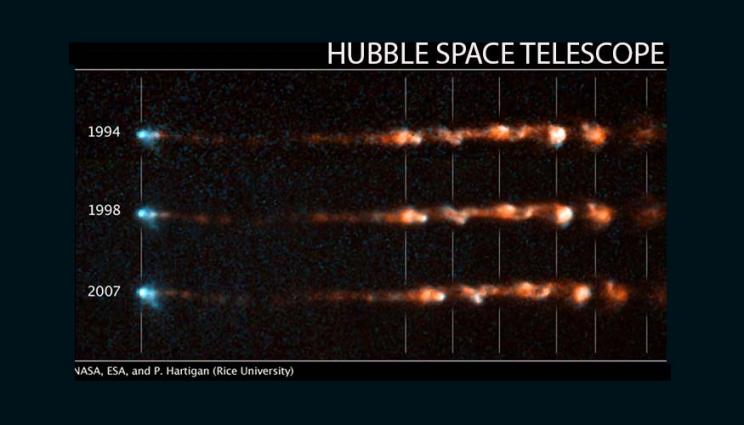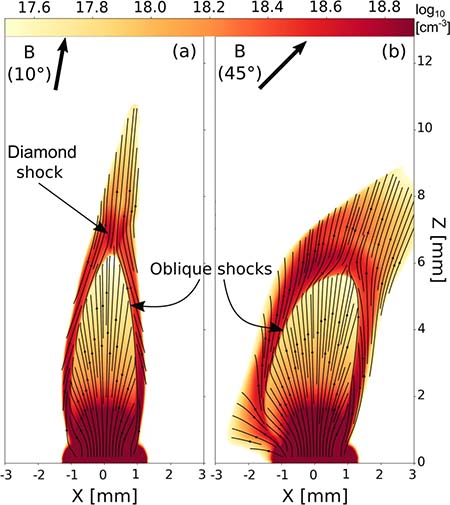
This image taken with the Hubble Space Telescope shows how a bright, clumpy jet ejected from a young star has changed over time. Image courtesy of NASA.
Outflows of matter are general features stemming from systems powered by compact objects such as black holes, active galactic nuclei, pulsar wind nebulae, accreting objects such as Young Stellar Objects (YSO) and mature stars such as our sun.
But the shape of those outflows, or astrophysical jets, vary depending on the magnetic field around them.
In new experiments, a Lawrence Livermore National Laboratory (LLNL) scientist and international collaborators found that outflow/magnetic field misalignment is a plausible key process regulating jet formation. The research appears in Nature Communications.
Using a high-powered laser at the École Polytechnique, the team created fast material outflows in a strong applied magnetic field as a surrogate for potential astrophysics conditions. The team specifically looked at the impact on jet formation of a misalignment between where the jet first forms and then the magnetic field.
For small misalignments, a magnetic nozzle forms and redirects the outflow in a parallel jet. For larger misalignments, this nozzle becomes increasingly asymmetric, disrupting jet formation.
"We found that outflow/magnetic field misalignment is a plausible key process regulating jet collimation in a variety of objects from our sun's outflows to extragalatic jets," said LLNL plasma physicist Drew Higginson, a co-author of the paper. "They also could provide a possible interpretation for the observed structuring of astrophysical jets."
Astrophysical jets have varied morphologies from very high aspect ratio, collimated jets, to short ones that are either clearly fragmented or are just observed and are not able to sustain a high density over a long range.
But the mechanisms underlying these varied morphologies have been unclear. In light of observations made onto a variety of astrophysical objects, the team devised a possible scenario where the relative orientation between the outflow and the large-scale ambient magnetic field surrounding the object can play a major role orienting the dynamics of the outflow from a collimated one to a stunted, fragmented one.
Collaborators include University of Chicago; Institute of Applied Physics RAS, Nizhny Novgorod, Russia; Sorbonne Université, École Polytechnique; Institut Polytechnique de Paris, Palaiseau, France; Université de Bordeaux-CNRS-CEA, Talence, France; Universitá di Palermo, Palermo, Italy; Heinrich Heine Universität Düsseldorf, Düsseldorf, Germany; Universiá di Torino, Torino, Italy; INAF-Osservatorio Astronomico di Palermo, Palermo, Italy; and Joint Institute for High Temperatures RAS, Moscow, Russia.
The Department of Energy supported the LLNL portion of the work.







